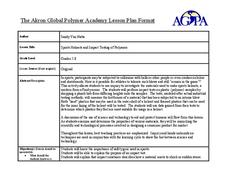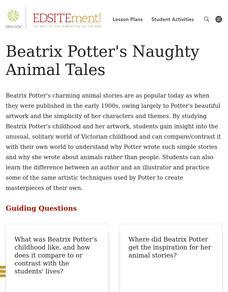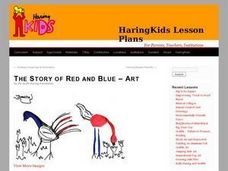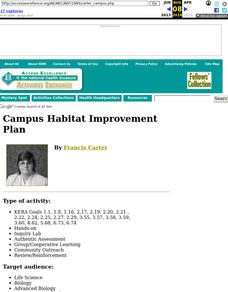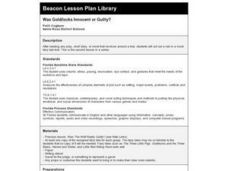National Endowment for the Humanities
Tales of the Supernatural
Scary stuff! Whether approached as the first horror story or a "serious imaginative exploration of the human condition," Frankenstein continues to engage readers. Here's a packet of activities that uses Mary Shelley's gothic novel to...
Curated OER
ReQuest Strategy: Reciprocal Questioning
Explore reciprocal questioning with this ReQuest comprehension strategy. After reading a passage, learners first question the teacher, trying to "stump" her. Then it is the teacher's turn to ask the pupils questions. All correct answers...
Curated OER
Platinum Perspectives
Students redesign a particular album cover of their choice in this excellent high school Art lesson. The lesson suggests using Adobe Photoshop and glossy inkjet paper for the final presentation of all products.
iCivics
Yeah, But...
Impress upon your young learners the importance of formulating counter arguments based on facts and not opinions. This resource is meant to strengthen arguments designed in a previous lesson, but could also be used as a stand-alone...
Achievement Strategies
CCSS Unit Design Template for PE
From baseball and tennis to capture the flag and four-square, here is a great document that will help you design your next unit on a sport-related activity.
Novelinks
Wildwood Dancing: Guided Imagery
Reader's of Wildwood Dancing engage in a guided imagery exercise designed to encourage them to visualize the setting of Juliet Marillier's young adult fantasy novel.
J. Paul Getty Trust
Tag: Whose Values
Get young people thinking about their lives and current topics of social justice, advocacy, gender, race, and identity. After examining several works by Barbara Kruger, participants select a tag with one of the questions printed on it,...
Curated OER
Building on the Past
Students consider how the scientific advances of the past have contributed to the science topics reported on today in the Science Times section. After reading a current science article, they compare and contrast the way science was...
Curated OER
Protective Design
Over 3 or 4 class periods your young designers will create a wearable garment that provides some sort of protection from a danger in everyday life. In this fashion design lesson, young scholars investigate fear in our society and...
Curated OER
Imagine That! Analyzing Imagery
Poems by O. Henry, Marion Dane Bauer, Monty Roberts, and Langston Hughes provide the text for a study of symbolism, hyperbole, and imagery. Employing the “think-pair-share” strategy learners generate definitions of these terms and locate...
Curated OER
Introduction to Multimedia
Sixth graders effectively and efficiently use the software program Microsoft PowerPoint and its more common tools and create a multimedia presentation using their research and autobiographical information. They then give oral...
Curated OER
Inventions 2: The Impact
Students explore innovators and inventions. For this technology lesson, students investigate the issues inventors face as they tackle new technology. Students design their own realistic needs-based invention.
Curated OER
Design for Social Justice
Students create a solution to a social justice problem within their community. In this urban planning lesson plan, students read To Kill a Mockingbird by Harper Lee and A Lesson Before Dying by Ernest Gaines. Students then complete a...
Curated OER
Children's Book Creations
Students create a children's book version of the Japanese folk story "Momotaro Boy of the Peach" and present the story to elementary students. In this children's book lesson, students design their book to explain Japanese culture to...
Curated OER
Sports Helmets and Impact Testing of Polymers
Students examine the importance of good quality safety gear. In this investigative lesson, students will tests various polymers, collect data, and analyze the data to determine which polymer is best for safety helmets. They will design a...
Curated OER
Naming Shapes
Students study geometric shapes and practice naming them properly. In this geometry lesson, students work in groups to give definitions of the vocabulary to each other in their own words. Students also visit a lower grade and teach...
Curated OER
Beatrix Potter's Naughty Animal Tales
Students gain insight into the unusual, solitary world of Beatrix Potter's Victorian childhood and can compare/contrast it with their own world to explain why Potter wrote such simple stories and why she wrote about animals rather than...
Curated OER
Spaghetti Graphs
Learners work in pairs to test the strength of spaghetti strands. They collect and graph data to determine a line of best fit. Students create a linear equation to interpret their data. Based on the data collected, learners predict...
Curated OER
The Story of Red and Blue: Art
Young scholars identify art history by examining a list of images on-line. In this painting instructional activity, students identify the work of Keith Haring by researching the Internet and discuss his style of artwork. Young scholars...
Curated OER
Campus Habitat Improvement Plan
Students work to improve a plot of land. They assess the needs of the environment and formulate a plan. They plant trees and gardens, build bird boxes, construct waterholes. etc.
Curated OER
Was Goldilocks Innocent or Guilty?
Fourth graders act out a mock fairy tale trial. They use a fairy tale like "The Three Little Pigs", "Goldilocks and the Three Bears", "Hansel and Grete"l, and/or "Little Red Riding Hood".
Curated OER
Jazz it Up!
Students research the history and contributions of Jazz in their local environments. They then design and create a wide variety of presentations to share with the class using as many mediums as possible.
Curated OER
ReQuest and Motor Imaging with My Side of the Mountain
Fifth graders read "My Side of the Mountain." They create a pantomime using vocabulary words from the story. Students create three questions about the reading. They discuss the passage they read and act out words to help them better...
Curated OER
Linear Systems
Students solve and graph linear equations. For this algebra lesson, students solve systems of equations using elimination and substitution. They graph their answer and identify the point of intersection.
















